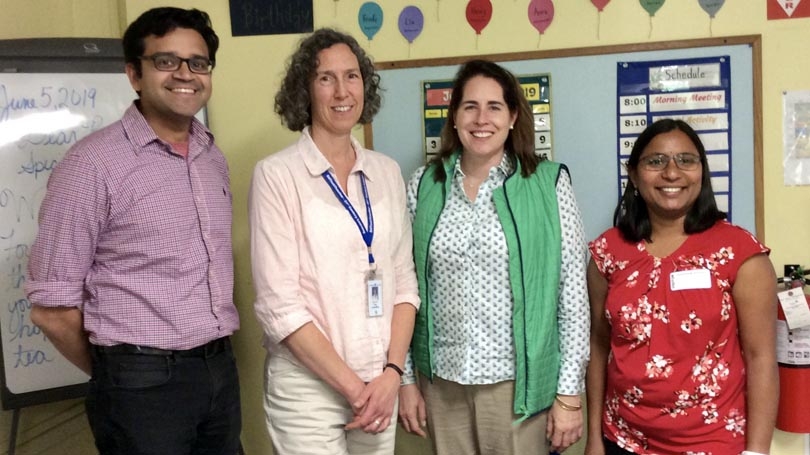
The Python team behind the coding curriculum L-R: Deeparnab Chakrabarty, Amy Kreuzburg, Liz O'Leary, Vasanta Lakshmi Kommineni (Photo: A. Kreuzburg)
In the summer of 2018, professor of computer science at Dartmouth Dr. Deeparnab Chakrabarty wanted to address a learning gap in coding curricula in K-12 schools. “Computer science has a very young history,” he notes, “unlike mathematics, for example, there is not a long tradition of teacher education, and in fact the technology is often 20 years ahead.” In fact, according to research published by Google in 20171, one of the biggest barriers to access to computer science education in K-12 schools is a lack of qualified teachers.
Deeparnab connected with Amy Kreuzburg and Liz O’Leary, teachers at Crossroads Academy in Lyme, New Hampshire to discuss the possibility of creating a coding curriculum for middle school students. Along with Vasanta Lakshmi Kommineni, an instructor in computer science at Dartmouth, they developed a series of lessons to teach Amy and Liz how to code in Python, and then all four of them worked together to design material for the fifth and sixth-grade students.
Amy says this opportunity came at a perfect stage in her own learning. “We had been developing a coding curriculum using Scratch for fifth and sixth graders,” she says. “I knew I had to take it up a notch, but I didn’t know where to start,” adding that she and Liz, the then-kindergarten teacher at Crossroads, felt that younger kids could also be learning coding.
Over a series of four meetings over the summer, with homework assignments in between, Vasanta and Deeparnab taught the teachers how to code. According to Deeparnab, the early success really hinged on the enthusiasm of the teachers. “There was a lot of content to digest, and Amy and Liz put in a lot of work.” They met for about ten hours in total over the summer, and then approximately eight more over November and December, with homework assignments and virtual support in between meetings.
“Previously, I was trying to piecemeal a curriculum together,” Amy says, “with Deeparnab and Vasanta’s help we were able to develop practice problems and create handouts and materials to develop a robust python coding curriculum.” The students used a Python group workspace called Repl.it where the practice problems and coding challenges could be coded and tested.
One of the students’ favorite challenges was cracking a password code, where they used Python to generate responses to find the correct password length. “The program and lessons really helped demystify the coding process, Amy said. “They’re having fun and the girls in particular are more likely to head into high school thinking coding is accessible to them.”
“We saw students really begin to believe they were capable of coding,” Deeparnab noted. “In particular girls, who may otherwise have held back, were demonstrating increasing confidence in their abilities and coding at very competent levels.”
“About twenty percent of students coming into computer science degrees have a very rudimentary understanding of coding,” Deeparnab says. “On seeing this need, I wanted to develop a program or workshop with teachers at local schools who would then be able to pass on that knowledge in easy to digest lessons to the students.” Deeparnab has plans to roll this program out to other local schools who are interested in developing a more robust coding curriculum.
“Tech is here to stay,” Amy notes, “I want students to feel comfortable and confident with it.”
1.Trends in the State of Computer Science in U.S. K-12 Schools, 2016